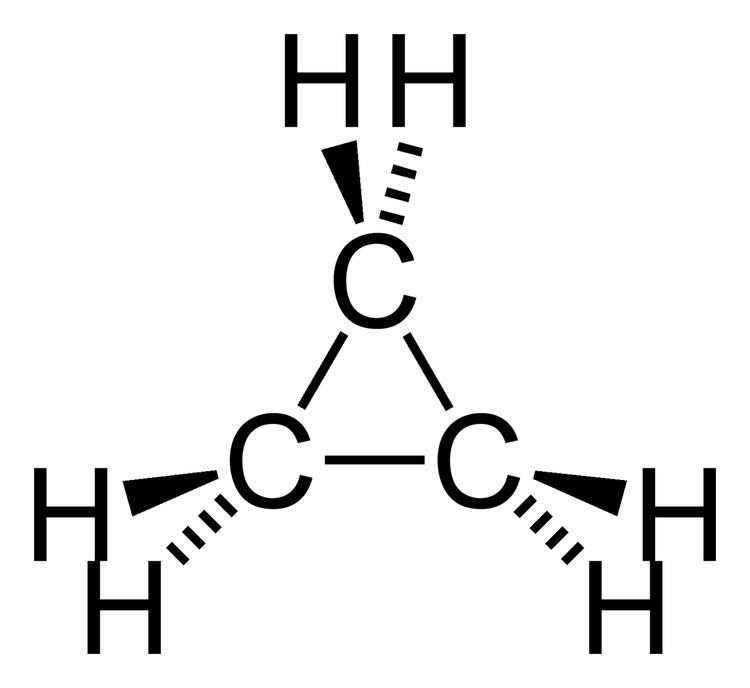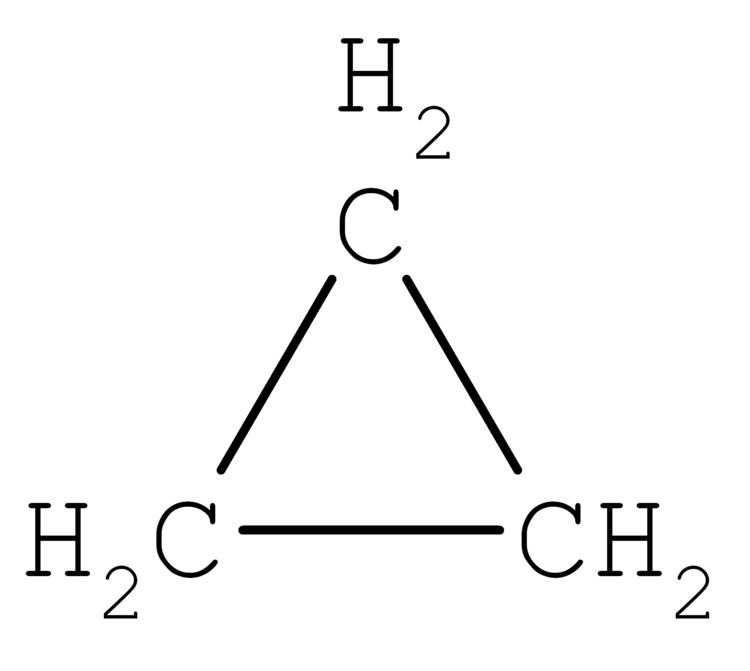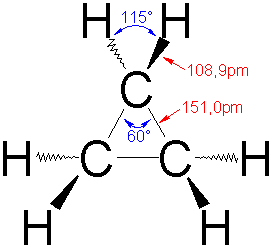Formula C3H6 Boiling point -32.86 °C Appearance Colorless gas | Molar mass 42.08 g/mol Density 1.88 g/cm³ | |
 | ||
Cyclopropane and cyclobutane
Cyclopropane is a cycloalkane molecule with the molecular formula C3H6, consisting of three carbon atoms linked to each other to form a ring, with each carbon atom bearing two hydrogen atoms resulting in D3h molecular symmetry. Cyclopropane and propene have the same molecular formula but have different structures, making them structural isomers.
Contents
- Cyclopropane and cyclobutane
- History
- Anaesthesia
- Pharmacology
- Structure and bonding
- Synthesis
- Cyclopropanation
- Reactions
- Safety
- References

Cyclopropane is an anaesthetic when inhaled. In modern anaesthetic practice, it has been superseded by other agents, due to its extreme reactivity under normal conditions: when the gas is mixed with oxygen, there is a significant risk of explosion.

History

Cyclopropane was discovered in 1881 by August Freund, who also proposed the correct structure for the new substance in his first paper. Freund treated 1,3-dibromopropane with sodium, causing an intramolecular Wurtz reaction leading directly to cyclopropane. The yield of the reaction was improved by Gustavson in 1887 with the use of zinc instead of sodium. Cyclopropane had no commercial application until Henderson and Lucas discovered its anaesthetic properties in 1929; industrial production had begun by 1936.
Anaesthesia

Cyclopropane was introduced into clinical use by the American anaesthetist Ralph Waters who used a closed system with carbon dioxide absorption to conserve this then-costly agent. Cyclopropane is a relatively potent, non-irritating and sweet smelling agent with a minimum alveolar concentration of 17.5% and a blood/gas partition coefficient of 0.55. This meant induction of anaesthesia by inhalation of cyclopropane and oxygen was rapid and not unpleasant. However at the conclusion of prolonged anaesthesia patients could suffer a sudden decrease in blood pressure, potentially leading to cardiac dysrhythmia; a reaction known as "cyclopropane shock". For this reason, as well as its high cost and its explosive nature, it was latterly used only for the induction of anaesthesia, and has not been available for clinical use since the mid 1980s. Cylinders and flow meters were coloured orange.
Pharmacology

Cyclopropane is inactive at the GABAA and glycine receptors, and instead acts as an NMDA receptor antagonist. It also inhibits the AMPA receptor and nicotinic acetylcholine receptors, and activates certain K2P channels.
Structure and bonding
The triangular structure of cyclopropane requires the bond angles between carbon-carbon bonds to be 60°. This is far less than the thermodynamically most stable angle of 109.5° (for bonds between atoms with sp3 hybridised orbitals) and leads to significant ring strain. The molecule also has torsional strain due to the eclipsed conformation of its hydrogen atoms. As such, the bonds between the carbon atoms are considerably weaker than in a typical alkane, resulting in much higher reactivity.
Bonding between the carbon centres is generally described in terms of bent bonds. In this model the carbon-carbon bonds are bent outwards so that the inter-orbital angle is 104°. This reduces the level of bond strain and is achieved by distorting the sp3 hybridisation of carbon atoms to technically sp5 hybridisation, (i.e. 1⁄6 s density and 5⁄6 p density) so that the C-C bonds have more π character than normal (at the same time the carbon-to-hydrogen bonds gain more s-character). One unusual consequence of bent bonding is that while the C-C bonds in cyclopropane are weaker than normal, the carbon atoms are also closer together than in a regular alkane bond: 151 pm versus 153 pm (average alkene bond: 146 pm).
Cyclic delocalization of the six electrons of cyclopropane's three CC σ bonds was given by Michael J. S. Dewar as explanation of the - compared to cyclobutane - relatively low strain energy of cyclopropane ("only" 27.6 vs. 26.2 kcal mol−1, cyclohexane as reference with Estr = 0 kcal mol−1 ). This stabilization is referred to as σ-aromaticity, cf. the cyclic delocalization of the six π electrons in benzene as the archetypical example of aromaticity. Other studies do not support the role of σ-aromaticity in cyclopropane and the existence of an induced ring current; such studies provide an alternative explanation for the energetic stabilization and abnormal magnetic behaviour of cyclopropane.
Synthesis
Cyclopropane was first produced via a Wurtz coupling, in which 1,3-dibromopropane was cyclised using sodium. The yield of this reaction can be improved by exchanging the metal for zinc.
BrCH2CH2CH2Br + 2 Na → (CH2)3 + 2 NaBrCyclopropanation
Cyclopropane rings are found in numerous biomolecules (e.g., pyrethrins, a group of natural insecticides) and pharmaceutical drugs. As such the formation of cyclopropane rings, generally referred to as cyclopropanation, is an active area of chemical research.
Reactions
Owing to the increased π-character of its C-C bonds, cyclopropane can react like an alkene in certain cases. For instance it undergoes hydrohalogenation with mineral acids to give linear alkyl halides. Substituted cyclopropanes also react, following Markovnikov's rule.
Safety
Cyclopropane is highly flammable. However, despite its strain energy it is not substantially more explosive than other alkanes.
